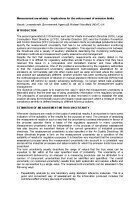Air monitoring
Measurement uncertainty – implications for the enforcement of emission limits
Oct 03 2014
Author: Maciek Lewandowski & Michael Woodfield on behalf of CEM
INTRODUCTION
The second generation EC Directives such as the Waste Incineration Directive (WID), Large Combustion Plant Directive (LCPD), Solvents Directive (SD) and the Pollution Prevention and Control Directive (IPPC) impose not only emission limits on individual pollutants but also specify the measurement uncertainty that has to be achieved by automated monitoring systems and incorporated in the process of regulation. This approach creates a link between the Directives and a variety of auxiliary standards describing the monitoring techniques, calibration methods and measurement quality assurance and management.
Despite the fact that measurement uncertainty requirements are clearly stated in the Directives it is difficult for regulatory authorities across Europe to ensure that they have resolved this issue in a comparable and consistent manner and have effective implementation procedures. One of the problems encountered by the regulatory authorities is that the measurement uncertainty assessment methodologies established for air emissions do not translate well into other media such as water and land where the custom and practice are substantially different. Another problem has been continuing adherence to the methodological principle of reliance on manual standard reference methods (SRMs) that have been left behind by rapidly advancing technology, no longer reflect best available techniques, and may not be best suited to act as a basis for measurement qualitymanagement.
The objective of this paper is to examine the way in which the measurement uncertainty is estimated and to find the best way of using uncertainty information in the regulatory process. The philosophy of compliance assessment is also reviewed in order to establish the best practice allowing for technically sound and legally robust approach where a measure of noncompliance
severity is defined leading to different follow-up actions.
Digital Edition
AET 28.4 Oct/Nov 2024
November 2024
Gas Detection - Go from lagging to leading: why investment in gas detection makes sense Air Monitoring - Swirl and vortex meters will aid green hydrogen production - Beyond the Stack: Emi...
View all digital editions
Events
Jan 12 2025 Abu Dhabi, UAE
Jan 14 2025 Abu Dhabi, UAE
Jan 20 2025 San Diego, CA, USA
Carrefour des Gestions Locales de L'eau
Jan 22 2025 Rennes, France
Safety, Health & Wellbeing LIVE
Jan 22 2025 Manchester, UK















